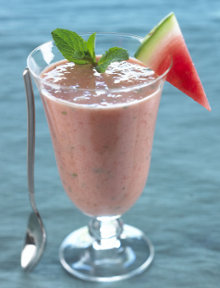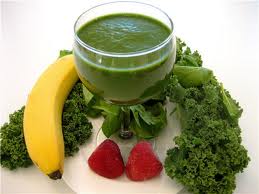A smoothie (also spelled smoothy) is a thick blended beverage with shake like consistency, normally pureed in a blender containing fruits and/or vegetables as well as an added liquid such as fruit juice, vegetable juice, milk, or even yogurt.

Smoothies Have 3 Main Parts
Traditionally, most smoothies consist of three parts: some type of liquid (often called the "base" of the smoothie), an assortment of fruits and/or vegetables, and ice. If frozen fruit or vegetables are used, the cool temperature can be achieved without using ice.
Thickness and Optional Ingredients
The "thickness" of a smoothie is usually determined by the ratio of liquids to solids, so to thicken any smoothie recipe you can generally reduce the amount of added liquid or conversely increase the amount of added fruit or vegetables. Optionally, some people add powders to a smoothie for additional supplementation and flavoring which also increases the thickness. An example of this is flavored protein powder or vitamin supplements.
Toppings, Garnishes, and Appearance
Garnishes such as fresh mint leaves and partially chopped or whole fruit like lemon wedges or slices are increasingly being used to decorate smoothies in recipes. The marketing of smoothies has led to this "dressing up" to make them look more attractive in advertising and overall more aesthetically appealing.
What is a Smoothie compared to a Shake?
Some smoothie recipes contain ice cream or large amounts of added sugar in the form of honey, chocolate syrup, or other additives. The addition of ice cream and particularly large amounts of processed sugar would more likely qualify the resulting beverage as being a shake, rather than a smoothie, as smoothies traditionally don't have added dairy or sugars, and consist only of "natural" non-processed ingredients.
What is a Smoothie vs Juice?
A Smoothie is traditionally made of "mixed" or "blended" whole fruits and vegetables, hence the requirement that the preparation requires the use of a blender. Juices are made by extracting only the liquid of a fruit or vegetable. A smoothie, on the other hand, typically contains the fruit or vegetable in its entirety, providing the additional health benefits of the roughage, skin, seeds, and other parts left out by juicing. Thus, a smoothie contains all the original fiber from the fruits and vegetables, while juice contains only the extracted liquid.
Potential Advantages of Smoothies vs Juice
The job of a juicer is purely to extract juice from the roughage and fiber. Juicing can be an effective way to distribute nutrients to people with limited digestive capacities or those who are being treated for illness. However, smoothies have the added benefit that in addition to maintaining the fiber content they can also incorporate sources of solid protein and fat, making them a more macro-nutrient balanced meal and also prromoting satiety.
A common criticism of fresh juice is that the high concentration of natural sugars cause a rapid rise in blood sugar. There also isn't a practical way to get significant sources of healthy fats from juicing, therefore the juice must be supplemented with additional foods if a rounded macro-nutrient profile is desired. A fresh smoothie does not undergo the same type of processing that store bought juices do, meaning that they will generally have a higher nutritional value.
Types and Categories of Smoothies
People have been making smoothies for almost 100 years, and in that time the process of finding new ingredients has led to the development of different types or categories of smoothies, which can be roughly divided into the following:
- Fruit Smoothies: A smoothie made from fruits, specifically for their sweet flavor.
- Green Smoothies: Smoothies typically dark green in color due to their use of dark vegetable greens such as spinach.
- Healthy Smoothies: Any smoothie whose aim is to optimize the amount of nutritional content, with the goal of replacing supplements and providing all of one's daily recommended vitamins and macro-nutrients in a natural form.
- Weight Loss Smoothies: These typically exclude any added sugar (with the aim of minimizing the overall glycemic load of the smoothie), and often contain healthy fats such as flax seed or almond butter to help satiate one's appetite. Caffeine based stimulants like green tea or coffee can also be added which further promote weight loss by both increasing metabolism and reducing appetite.
- Dessert Smoothies: Dessert smoothies typically contain added sugar or fat in the form of ice cream or syrups - many recipe books call for smoothies with either added sugar or dairy products creating a dessert like beverage, which in many cases tastes identical to a shake.
Making Smoothies
If you are interested in learning more please check out our authoritative how to make a smoothie guide.

